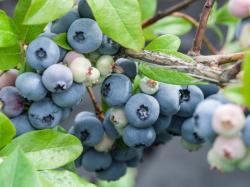Blueberry Industry Conducts Election Of State Council Members For US Highbush Blueberry Council
May 3, 2016 | 3 min to read

Members of the highbush (cultivated) blueberry industry are being asked to select representatives to fill state council member and alternate positions on the U.S. Highbush Blueberry Council (USHBC) Blueberry Promotion, Research and Information Order. Eight USHBC state member and alternate seats need to be filled for the term of office beginning January 1, 2017. Eligible voters are those who produced 2,000 pounds or more of highbush blueberries in the United States during the period of January 1, 2015 to December 31, 2015.
Election of council members and alternates for New Jersey, Georgia Oregon, Washington, North Carolina and California will be handled by their individual state blueberry councils and commissions.
Growers in the states of Michigan and Florida will vote for their representative. Nominations for Michigan and Florida state members were conducted from March 11 to April 15, 2016. The USHBC is mailing ballots to Michigan and Florida blueberry growers who received nomination applications earlier this year. Candidates identified during the nomination process are listed on the final Michigan and Florida ballot. Space is also made available on the ballot for write-in candidates Ballots will also be posted on the USHBC website at www.blueberry.org. Voting begins June 10, 2016 and continues for a five week voting period. Voters are being asked to complete their ballot and send it back to the U.S. Highbush Blueberry Council (USHBC) to be received no later than by close of business on July 15, 2016. Those who do not receive a ballot by June 10, 2016 can obtain a copy by contacting the USHBC office at (916) 983-0111 (phone) or (916) 983-9022 (fax). Those receiving the most votes for each producer seat will be recommended to the Secretary of Agriculture as council members. Those who earn the second most votes for each position will be recommended as the alternate. Those who receive the third and fourth most votes will also be reported to the Secretary of Agriculture for consideration.
Council members and alternates will serve for a term of three years starting in 2017 and will be allowed to serve a maximum of two consecutive terms.
The USHBC has adopted a diversity outreach plan to attempt to achieve a diverse representation on the Council. USHBC programs are open to all individuals without regard to race, color, national origin, sex, religion, age, disability, political beliefs, sexual orientation, genetic information, parental
status and marital or family status. It is USHBC policy that membership on the Council and its committees reflect the diversity of individuals served by its programs.
To accomplish this objective, the USHBC will strive to attain representation of growers and other industry participants from diverse backgrounds on the Council and USHBC committees. To this end, the USHBC strongly encourages women, minorities and persons with disabilities to seek nominations to the USHBC and to participate in Council and USHBC committee activities.
Producers and importers of highbush blueberries approved the establishment of the national promotion program through a referendum conducted by the USDA Agricultural Marketing Service in 2000. In this initial referendum, 68% of those who voted favored implementation of the order. Those who voted in favor represented 73% of the volume of highbush blueberries represented in the referendum. As required every five years by the USDA, a continuation referendum on the USHBC was conducted in 2006 with the Council receiving a strong endorsement from the industry with 87% of those who voted voting in favor (94% of the volume of highbush blueberries represented in the referendum). A second continuation referendum conducted in 2011 showed that 88% of those who voted favored continuation of the order. Those who voted represented 98% of the volume of highbush blueberries represented in the referendum.
The program is funded by an assessment of $18 per ton on domestic highbush blueberries and $18 per ton on fresh or processed imported highbush blueberries starting in 2001. Market promotion activities funded through the USHBC program began in January of 2002.
Source: U.S. Highbush Blueberry Council (USHBC)
